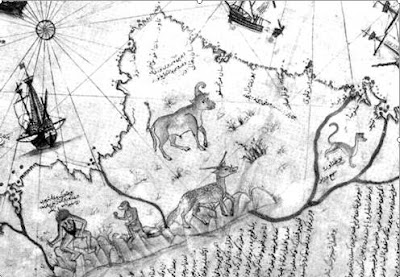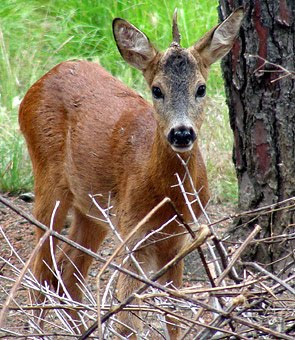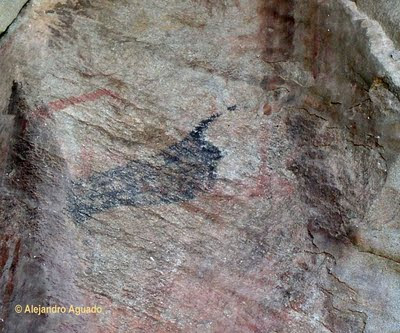Measured at last: tall but not giganticIn 1767, Captain Samuel Wallis took the HMS “Dolphin” back to Patagonia and actually measured the tallest natives with a rod. He proved that they were tall but not giants: “
one of these was six feet seven inches high [2.01 m], several more were six feet five, and six feet six inches high [1,96 to 1,98 m]; but the stature of the greater part of them was from five feet ten to six feet [1,78 to 1,83 m]”.[1]
He also the first to point out that their feet were “
remarkably small”;[1] putting in doubt the myth about big footed Patagons.
That same year French Explorer Louis de Bougainville commented on their “
good height” and strong but not gigantic build.[2]
Spanish Admiral Alonso de Cordova measured them accurately in 1785/6, and found that the tallest did not exceed 2 m (6 ft. 7 in.) and that their average height was between 1,83 and 1,97 m (6 – 6 ft. 6 in.).[3]
Jesuit Father Falkner also wrote about a Tehuelche chief, by the name of Cangapol, who was “
seven feet and some inches tall” [over 2.10 m], yet he noted that he “
never heard about that nation of giants mentioned by others” despite having seen members of all the southern tribes;[4] except the tall and stout Buta-Guillín who may have been the “real” giants.
It appears that during the closing years of the eighteenth century, Illuminism and modern science marked a change: the giants suddenly disappeared from Patagonia and were replaced by very tall men –humans not giants.
In 1780, Spanish official, Antonio de Viedma, who explored the Patagonian coast, reported their height was between two varas and nine palms, that is 1,63 to 1,89 m (5.3 to 6.2 ft.). He believed that their build “
thick in proportion to their height” and the fact that they wore bulky guanaco furs as clothes, may have fueled the stories that depicted them as giants.[5]
In 1826, English Captain Phillip Parker King noted that the natives’ height was “
between five feet ten and six feet [1.78 – 1.83 m]”.[6]
Captain FitzRoy, who was accompanied to Patagonia by Charles Darwin (of evolutionary fame), wrote in 1833 that they were “
a tall and extremely stout race of men” of which very few measured less than “
five feet nine or ten” [1,75 -1,78 m].[7] Once again tall but not gigantic.
Alcide D’Orbigny, a French naturalist also measured them at the Rio Negro River in 1828 found them shorter: 1,73 cm [5 ft. 8 in.].[8]
Argentine explorer Francisco Moreno attributed D’Orbigny’s low height to the fact that he mistook shorter Pampa natives for real Patagon Tehuelche. Moreno’s measurements of pure blooded Tehuelche gave a greater figure: their average height was 1,86 m [6 ft. 1 in.].[9]
George Musters, an Englishman who travelled with them for over a year in 1870 estimated the mean height of the Aonikenk Tehuelche in his group as “
five feet and ten inches [1,78 m]”.[10] He also gave an explanation for their “big” feet myth:
hide overshoes are worn [besides their horse skin boots] and the footprints thus made are really large enough to convey the idea of giant’s feet, and partly explain the term ‘Patagón’, or large feet.[10]
He also noted that their “
feet […] were frequently smaller than mine”. This definitively debunked the “big feet” myth.
English sailor giving a giant Patagon woman a biscuit for her child.
From: [11]. Anon. Front Plate.
Was there a tribe of giants?So, we have seen that there is conflicting evidence. Some explorers saw men of gigantic proportions; others saw tall and well built men, but not giants. What can we make out out of this?
There is no doubt that the Tehuelche people are of a great height, comparable to that of the Sudanese Dinka, the Dutch and Croatians, who nowadays are the tallest people on Earth.
To XVI
th century Europeans, the tall Tehuelche must have appeared enormous. At that time, the average height of northern Europeans was barely 1,67 m (5 ft. 6 in.) and southern Europeans were even shorter (1.5 m or 5 ft.). When face to face with men over 30 cm (1 ft.) taller than them, they must have been very impressed and indubitably would have called them giants.
Unfortunately, the Tehuelche as a race disappeared in the late XIX
th century; the proud, strongly built and tall natives of the Patagonian steppes are now only a memory. But, as reported by Van Noort, Frezier and Byron, the Tehuelche were not alone; there was another group, gigantic and warlike, the
Tiremenen.
Could they have been the bearded bellicose
Caucauhue seen by De Rueda and not reported by any other explorer since 1641?
Though contrary to contemporary mainstream anthropologists’ views who do not record any tribe of gigantic stature in the region, we believe that there may be some truth underlying van Noort’s
Tiremenen.
It may be possible that they were a tribe of slowly vanishing giant men; a group of “foot-Indians” unable to compete with the horse riding Tehuelche. They were probably weakened by illnesses borne by the first European explorers, against which they had no defenses (small-pox, measles or even the common cold). Both factors –illness and war- forced them to retreat away from the coast where they had first been seen by the Europeans, into the Andes, their last bastion against their fierce Tehuelche enemies.
They somehow managed to survive until the late 1700s when they were last seen, and after bloody battles with the Southern Tehuelche groups (Aonikenk), they quite suddenly disappeared.
We find corroboration of this hypothesis in the reports of the XIX
th century Patagonian explorers:
Ned Chace, an American who lived in Patagonia between 1898 and 1929 had heard from contemporary natives of “
Indians in Patagonia different from the Tehuelches, bigger than they, and hostile to them”.[49] Unlike the Tehuelche who used
boleadoras (for information on these stone weapons, see our post on
Tachwüll), they used the same stone tipped arrows and “
bola perdida” that the Paleo-Indians –and Pigafetta’s Patagons- had employed. This clearly indicates their pedestrian way of life (bow and arrows are difficult to use while riding a horse).
He also had heard of the killing of the last of these giant Indians, which had been “
caught by the Tehuelches in a cave near Gallegos and smoked to death there”.[12]
Chace was sure that they were giants because he had dug up some old graves and in one found a very large leg bone that when rested on the ground “
came two inches [5 cm] above his knee. Chace was 5 ft. 11 in. tall [1,80 m]” so the bones were indeed large.[12]
There are however true and reliable reports on ancient stories of terrible battles fought in Southern Santa Cruz, where tribe decimated tribe; these may reflect the dying throes of the giant
Tiremenen.
Italian explorer Giacomo Bove in 1881 wrote that a local “gaucho” (Argentine cowboy) named García told him that while driving cows through southern Santa Cruz, he came across “
a valley full of bones”; they were gigantic, and human, belonging to “
an extinguished race […] a nation of men with colossal skeletons”.[13]
Argentine explorer Ramón Lista heard similar tales from the Aonikenk and wrote about some caves along the middle course of the Gallegos River, which he believed “
may be the homes of a race defeated by the Tehuelche”.[14]
Carlos M. Moyano, an officer of the Argentine navy had already explored these caves in 1886, reporting that the ground was strewn with their bones, his native guide told him that it was a place where, “
many Indians of ‘yore’ had fought”. [15]
Coinciding with Chace’s comments, Moyano noted that one of the caves was known as the “grotto of the asphyxiated”.
The succinct evidence mentioned above hints that, after all, there could be some truth in the myth of the Patagonian giants, the
Tiremenen, proud members of a bellicose tribe that quietly vanished from the face of the Earth after being vanquished by their fellow Tehuelche. Their bones turning to dust by the Gallegos River.
My humble homage to them is this “unofficial stamp”:
My homage to the great Patagones, a stamp. Copyright © 2007 by Austin Whittall
Previous posts:
Read about
Giants - Part 1.
Read about
Giants - Part 2.
Bibliography.[1] Hawkesworth, J., (1773). Op. Cit. pp.68
Ibid. pp. 374.
[2] De Bougainville, L., (2004).
Viaje alrededor del mundo: en la fragata real Boudeuse y el Etoile. B. Aires: Continente. pp. 53.
[3] de Cordoba, A., (1820).
A voyage of discovery to the Strait of Magellan…. London: Printed for Sir R. Phillips. pp. 85+
[4] Falkner, T., (2008).
Descripción de Patagonia y de las partes adyacentes de la América meridional. B. Aires: Continente. pp. 52 and 117.
[5] de Viedma, A., De Angelis, [Comp] (1837).
Diario de un viaje a la costa de Patagonia, para reconocer los puntos en donde establecer poblaciones. B. Aires: Imprenta del Estado. pp. 68.
[6] King, P. P., (1839).
Narrative of the surveying voyages of His Majesty's Ships Adventure and Beagle… London: Henry Colburn. pp. 96.
[7] FitzRoy, R., (1839). Op. Cit. v.ii. pp. 134-5.
[8] D’Orbigny, A., (1999).
Viaje por la América meridional II. Buenos Aires: Emecé. pp. 305.
[9] Moreno, F., (2007).
Exploración de la Patagonia Sur II: el lago Argentino y los Andes meridionales. 1877. B. Aires: Continente. pp. 114.
[10] Musters, G. Op. Cit. pp. 153+
[11] Anon. “
English sailor giving a giant Patagon woman a biscuit for her child”. (1769). [Engraving]. In Byron, J., Gómez Ortega, C. [Ed.] (1769).
Viage del comandante Byron alrededor del... Madrid: Real Gazeta. Front Plate.
[12] Le Moyne Barrett, R., and Barrett K., (1931).
A Yankee in Patagonia, Edward Chace. Boston: Houghton Mifflin. pp. 89 - 90.
[13] Bove, G., (2005).
Expedición a la Patagonia: un viaje a las tierras y mares australes 1881-1882. B. Aires: Continente. pp 16-7.
[14] Lista, R., (2006).
Viaje a la Patagyonia Austral (1879). Los indios tehuelches. Una raza que desaparece (1894). B. Aires: Continente-Pax. pp. 86.
[15] Moyano, C., (1999).
Exploración de los rios Gallegos, Coile, Santa Cruz y Canales del Pacífico. B. Aires: Ed. Confluencia. pp. 25 - 32.
Copyright 2009 by Austin Whittall ©Patagonian Monsters
















































